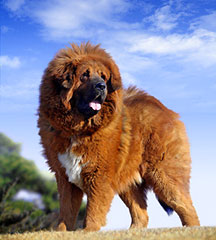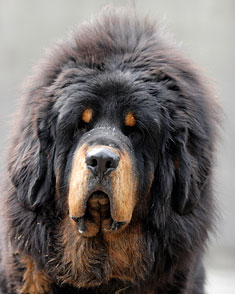Dog Breed:
Tibetan Mastiff

Other Common Names:
Do-Khyi
Description:
Large and powerful, the Tibetan Mastiff has thick bones and a large bear-like head with a wide blunt muzzle. Marco Polo described the Tibetan mastiff as "tall as a donkey with a voice as powerful as that of a lion." The Tibetan Mastiff has a mane and some adult males have dewlaps around the neck, while the feathered tail curls around its back.

Country of Origin:
The Tibetan Mastiff dog breed originated in Tibet.
Height:
Tibetan Mastiffs range between 25 and 28 inches (61 to 71 cm.) `in height.
Weight:
A Tibetan Mastiff will weigh between 140 and 170 pounds (64 to 78 kg.)
Colors:
Tibetan Mastiffs may be chocolate, blue & tan, sable, gold, cream, or red, with or without tan markings.
Coat:
Tibetan Mastiffs require weekly brushing. Their coat grows thicker in the winter and this is shed in the spring/summer period, at which point they should be brushed once a day for 30 minutes a day.
Temperament:
A natural family and guard dog, the Tibetan Mastiff is calm but highly protective and territorial. Tibetan Mastiffs should be trained to be mutually respectful of their owners. If another dog is to be introduced into the house, it should be of the opposite sex, non-dominant and spayed or neutered.
Health Concerns:
Tibetan Mastiffs are not suited for hot climates. They are prone to hip dysplasia, skin conditions, thyroid problems, ear infections, and an unusual genetic problem called Canine Inherited Demyelinative Neuropathy (CIDN).
Life Expectancy:
The Tibetan Mastiff can be expected to live about 15 or more years.
Living Environment:
Tibetan Mastiffs are not suited for apartment life and require a medium sized yard. This breed should be brought indoors at night as it is a nocturnal barker, but will be quiet in the house. The Tibetan Mastiff is a digger and a climber and will try to escape, so it requires a well fenced yard around its perimeter. Tibetan Mastiffs enjoy walks but are not suited for jogging. They are also not interested in playing with balls.
AKC Group:
The Tibetan Mastiff is in the Working Group